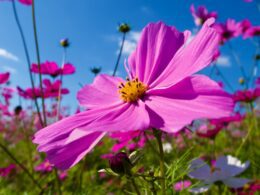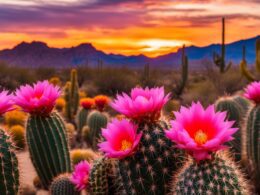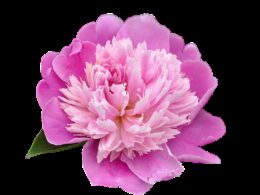Do you want a garden that is easy to maintain and always looks vibrant? Look no further than perennials. These plants are a staple in any garden, and for good reason. They come back year after year, saving you time and money, while also providing a beautiful display of color.
But with so many options out there, how do you know which perennial is the most popular? Well, fear not, because we’ve got you covered. In this article, we’ll explore the world of perennials and reveal the top contenders for the title of most popular.
We’ll also dive into what makes these plants so beloved by gardeners around the world. By the end of this article, you’ll have all the information you need to choose the perfect perennial for your garden and create a safe and welcoming outdoor space.
The Importance of Perennials in Gardening
You can’t underestimate the value that perennials bring to your garden, providing year-round interest and low-maintenance beauty. These plants are a great investment since they come back every year, and they require less upkeep than annuals. Perennials can add texture, color, and height to your garden, and they can also attract pollinators like bees and butterflies.
One of the benefits of perennials is that they require less maintenance than other plants. Once you’ve planted them, they’ll come back year after year without you having to do much. However, this doesn’t mean that perennials don’t need any care. You’ll still need to water them regularly, especially during dry spells, and prune them to keep them healthy. You’ll also need to divide them every few years to prevent overcrowding.
Another drawback of perennials is that they can be expensive to buy. However, you can save money by buying them in bulk or propagating them yourself. You can also choose perennials that are native to your area, which’re often more affordable and better adapted to your climate.
Overall, perennials are a great addition to any garden, providing beauty and interest year after year with minimal effort on your part.
Factors that Influence Popularity
When it comes to popularity of perennials, there are several factors to consider.
First, the climate and location of your garden play a big role in determining which perennials thrive.
Second, personal preference is key; what looks good to one person may not look good to another.
Finally, availability is also a factor; not all perennials are readily available in every region or nursery.
Climate and Location
Living in the right climate and location can make all the difference when it comes to growing the perfect perennial. The weather patterns and soil type of your area play a crucial role in determining which perennials will thrive and which ones will struggle.
For instance, if you live in a dry and arid region, you’ll want to choose perennials that can handle drought conditions. On the other hand, if you live in a region with heavy rainfall, you’ll want to choose perennials that can tolerate excess moisture.
Moreover, the soil type of your area can also impact the success of your perennials. Different perennials have different soil preferences, and it’s important to choose ones that will grow well in your soil.
For example, if you have clay soil, you’ll want to choose perennials that can handle heavy soil, such as daylilies or peonies. Alternatively, if you have sandy soil, you’ll want to choose perennials that can handle well-drained soil, like lavender or sedum.
By considering the climate and location of your area, you can choose the best perennials for your garden and ensure their success.
Personal Preference
Now it’s time to talk about what really matters – what you love! When choosing the most popular perennial for your garden, personal preference plays a major role.
Here are some things to consider when choosing the perfect perennial for you:
-
Growth habits: Do you prefer a tall, upright plant? Or maybe you like a low growing ground cover? Consider the growth habits of the perennial you’re interested in, and make sure it fits your aesthetic preferences.
-
Flower colors: Some people prefer bright, bold colors, while others prefer more muted shades. Take a look at the flower colors of the perennials you’re considering, and choose the ones that make you happiest.
Remember, your garden is a reflection of you and your personality. Choose the perennials that make you feel the most joyful and fulfilled.
When it comes to personal preference, there’s no right or wrong answer. It’s all about what makes you happy. Don’t be afraid to mix and match different perennials to create a garden that’s uniquely yours. Choose the plants that speak to you, and enjoy watching them grow and thrive in your garden. With so many beautiful perennials to choose from, the possibilities are endless!
Availability
Consider the availability of different perennial options to ensure that you can find and grow the perfect plants for your garden. When it comes to growing perennials, you want to choose a plant that will be easy to find and maintain.
Some popular options include daylilies, hostas, and coneflowers. These plants are widely available at garden centers and online, making them an excellent choice for those who want to add some color and variety to their outdoor space.
When it comes to perennial maintenance, it’s important to choose plants that are suited to your climate and soil type. This will help ensure that they thrive and require less upkeep over time. It’s also a good idea to choose plants that are resistant to pests and disease, as this will help keep them healthy and looking their best.
By taking the time to research and choose the right perennials for your garden, you can enjoy a beautiful and low-maintenance outdoor space for years to come.
Is Salvia Considered as One of the Most Popular Perennials?
Salvias as perennial plants have gained substantial popularity among gardeners worldwide. Known for their vibrant colors and attractive blossoms, salvias thrive year after year, making them a go-to choice for many gardening enthusiasts. With their ability to withstand various weather conditions, these hardy perennials offer an enduring beauty that continually captivates garden lovers.
Top Contenders
The top contenders for this category are sure to impress any gardener looking to add some long-lasting beauty to their space. These perennials are known for their best performing and unique characteristics that make them stand out from the rest.
Here are some of the top contenders that you might want to consider:
-
Black-eyed Susan: This perennial is a classic favorite among gardeners. It adds a pop of yellow or orange color to your garden and can thrive in almost any soil condition. Black-eyed Susan is also known for its ability to attract butterflies and bees, making it a perfect addition to any pollinator garden.
-
Daylily: Daylilies are another popular perennial that come in a variety of colors and sizes. They are low-maintenance and easy to grow, making them perfect for beginner gardeners. Daylilies are also known for their ability to bloom for weeks, providing you with long-lasting beauty in your garden.
-
Coneflower: Coneflowers are not only beautiful but also have medicinal properties. They are known for their ability to boost the immune system and fight off infections. Coneflowers come in a variety of colors, from pink to purple, and are perfect for attracting birds and butterflies to your garden.
Adding any of these top contenders to your garden will surely give you long-lasting beauty and a sense of safety. These perennials are easy to grow and require little maintenance, making them perfect for those who want to spend less time taking care of their garden and more time enjoying it. So, go ahead and choose the one that best suits your taste and start planting!
What Makes These Perennials Popular
These top contenders have become favorites among gardeners because of their unique characteristics and ability to provide long-lasting beauty with little maintenance. Let’s take a closer look at what makes these perennials so popular. One of the main benefits of these perennials is that they come back year after year. This means less work for you and more time to enjoy your garden. Additionally, many of these perennials have beautiful blooms that last for weeks or even months.
However, there are some drawbacks to consider. While perennials may require less maintenance than annuals, they still need some care to thrive. This includes regular watering and fertilizing. Additionally, some perennials may be more susceptible to pests and diseases than others. It’s important to do your research and choose perennials that are well-suited to your climate and soil type.
Trends in perennial popularity are constantly evolving. While some perennials have been popular for decades, others are gaining popularity in recent years. For example, succulents have become a trendy choice for gardeners who want low-maintenance plants that are also drought-tolerant. Additionally, native plants are becoming more popular as gardeners seek to create landscapes that are environmentally friendly. Overall, the most popular perennials are those that offer unique beauty and low maintenance, but there is always room for new trends and innovations in gardening.
Conclusion: Choosing the Right Perennial for Your Garden
When it comes to choosing the perfect perennial for your garden, it’s important to consider your climate, soil type, and level of maintenance. Here are three things to keep in mind when making your decision:
-
Perennial maintenance: Some perennials require more upkeep than others. For example, roses need to be pruned regularly, while daylilies are relatively low-maintenance. Consider how much time and effort you’re willing to put into caring for your plants before making a final decision.
-
Soil preparation: Different perennials thrive in different types of soil. Some prefer well-drained soil, while others do best in damp, fertile soil. Before planting, make sure you’ve prepared your soil according to the needs of your chosen plants.
-
Climate considerations: Perennials are adapted to thrive in different climates. Some prefer cool, shady areas, while others do best in full sun and warm temperatures. Make sure you choose plants that are well-suited to your local climate to ensure the best chances of success.
By taking these factors into consideration, you can choose the right perennial for your garden and enjoy beautiful, long-lasting blooms for years to come. Remember to do your research, prepare your soil, and give your plants the care they need to thrive. With a little bit of effort, you can create a stunning garden that will be the envy of your neighborhood.
Frequently Asked Questions
What are some common pests and diseases that affect perennials?
Preventative measures and organic solutions are key to managing pests and diseases in perennials. Regularly inspect your plants for any signs of infestation and promptly remove any affected leaves or branches to prevent the spread of pests.
Using natural remedies such as neem oil or insecticidal soap can effectively control pests without harming beneficial insects.
Understanding root rot is also important when caring for perennials. Identify the signs of root rot, such as yellowing leaves or stunted growth, and treat it with proper drainage and soil amendments to save your plants from complete destruction.
By taking these preventative measures and implementing organic solutions, you can ensure the health and longevity of your beloved perennial plants.
How do I properly divide and transplant my perennials?
To properly divide and transplant your perennials, you’ll need a few essential tools. First, you’ll need a digging fork or shovel to carefully dig up the plant. Next, you’ll need pruning shears or a knife to divide the plant into smaller sections.
Once you have your tools ready, follow these simple steps. First, water the plant thoroughly the day before you plan to divide it. Then, dig up the entire plant, being careful not to damage the roots. Use your pruning shears or knife to divide the plant into smaller sections, making sure each section has enough roots and foliage to survive on its own.
Finally, plant each section in its new location, making sure to water it well. To ensure successful growth after transplanting, make sure to keep the soil moist and add a layer of mulch to help retain moisture. In addition, avoid transplanting during periods of extreme heat or cold, as this can stress the plant.
By following these tips and steps, your perennials should thrive in their new location.
Can I grow perennials in containers or do they need to be planted in the ground?
You might be surprised to learn that perennials can actually be successfully grown in containers! Container gardening is a great option for those with limited outdoor space or poor quality soil.
When choosing a container, make sure it has adequate drainage holes and is large enough to accommodate the particular perennial you want to grow. As for soil requirements, perennials need well-draining soil that is rich in organic matter. You can use a high-quality potting mix combined with compost to create the perfect growing medium for your perennial.
Just remember to water your container regularly and provide proper sunlight to ensure your perennial thrives in its new home.
What are some companion plants that work well with popular perennials?
Pairing companion plants with your favorite perennials can take your garden design to the next level. When choosing companions, consider the light, soil, and water requirements of both plants.
For example, pairing shade-loving hostas with sun-loving coneflowers won’t work. Instead, choose plants with similar needs and complementary colors. Some popular perennial and companion plant pairings include daylilies and catmint, peonies and lamb’s ear, and black-eyed Susans and goldenrod. These combinations not only look great together but also attract pollinators.
Remember to plant taller companions behind shorter perennials to create depth and interest. With these design tips, your garden will be the envy of the neighborhood.
How do I properly winterize my perennials to ensure their survival through the colder months?
To ensure your perennials survive the colder months, winterizing techniques are crucial. Start by cutting back dead foliage and stems to prevent disease from spreading.
Mulch around the base of the plant to protect roots from frost and extreme temperature changes. You can also cover the plant with burlap or a frost cloth to provide additional protection.
Water the plant deeply before the ground freezes to ensure it has enough moisture to survive. With these frost protection methods in place, your perennials will be able to weather the winter and come back strong in the spring.
Conclusion
So, now that you know the most popular perennials, how do you choose the right one for your garden?
Consider the climate and soil conditions in your area, as well as the amount of sunlight your garden gets.
Think about the aesthetic you want to achieve and whether you want a low-maintenance or high-impact plant.
Don’t be afraid to experiment and try different perennials in your garden. With their long lifespan and ability to bloom year after year, perennials can be a great investment for your garden.
By choosing the right perennial for your needs, you’ll be able to enjoy a beautiful and thriving garden for years to come.









